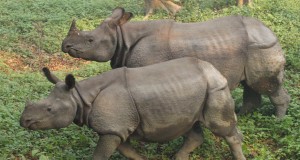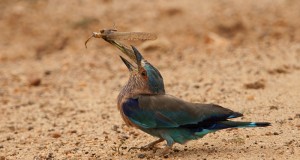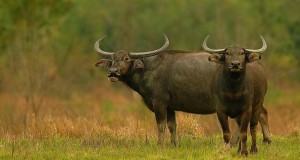The Periyar Wildlife Sanctuary, now one of the 16 Project Tiger Reserves in India, is an interesting example of how development need not be incompatible with the requirements of wildlife. A hundred years ago, a British engineer, Colonel J. Pennycuick, conceived a design to dam the Periyar river, which runs through some of the most spectacular forests of the Western Ghats in Kerala state in South India. The dam was constructed in 1895 and the adjoining forests protected by the Maharaja of Travancore. Today the 300-sq-mile (777-sq-km) sanctuary is a Tiger Reserve. The actual reservoir is 21 sq miles (55 sq km) and it meant that the best valley forests were submerged and lost. The black stumps still to be seen jutting out of the water, which are an eerie and wonderful sight in the early winter mornings as the mist rises, are the only remains of the richly vegetated valley. But the darn also made some compensations. Periyar has become one of the most picturesque wildlife sanctuaries in the world and is enjoyed by over 150,000 tourists every year. For the animals, the reservoir and surrounding forests provide protection and a perennial water supply.
in 1895 and the adjoining forests protected by the Maharaja of Travancore. Today the 300-sq-mile (777-sq-km) sanctuary is a Tiger Reserve. The actual reservoir is 21 sq miles (55 sq km) and it meant that the best valley forests were submerged and lost. The black stumps still to be seen jutting out of the water, which are an eerie and wonderful sight in the early winter mornings as the mist rises, are the only remains of the richly vegetated valley. But the darn also made some compensations. Periyar has become one of the most picturesque wildlife sanctuaries in the world and is enjoyed by over 150,000 tourists every year. For the animals, the reservoir and surrounding forests provide protection and a perennial water supply.
The best time to visit Periyar is between October and April, thus missing the southwest monsoon period. In March and April, when water gets low and the grass dries out, animals have to spend more time near the lake and elephants are especially dependent on the lake during this period. This is the ti me of year when they can often be seen bathing and swimming, both to cool off as well as to get from one feeding area to the next. The grass is also short during this time of year and animal visibility thus increased. Apart from the hotels, Aranya Nivas and Periyar House in the tourist complex area and the Lake Palace at Eddapaliyam, there are several rest houses which may be booked in advance and which are in prime wildlife areas and are very reasonably priced. Since boat travel is the only means of transport within the sanctuary (cars can go only up to the tourist center), large areas can be covered in a short time and a three- or four-day stay is satisfactory, with boat rides in the morning and evening and animal; bird watching on the lake shores in between. Sitting on the steps at Eddapaliyyam , the visitor can regularly watch gaur, elephant and wild pig on the opposite bank.
Eddapaliyam, there are several rest houses which may be booked in advance and which are in prime wildlife areas and are very reasonably priced. Since boat travel is the only means of transport within the sanctuary (cars can go only up to the tourist center), large areas can be covered in a short time and a three- or four-day stay is satisfactory, with boat rides in the morning and evening and animal; bird watching on the lake shores in between. Sitting on the steps at Eddapaliyyam , the visitor can regularly watch gaur, elephant and wild pig on the opposite bank.
However, for the more deeply interested visitor or naturalist who has the time and inclination, a longer stay is certainly worthwhile: Periyar is a truly spectacular s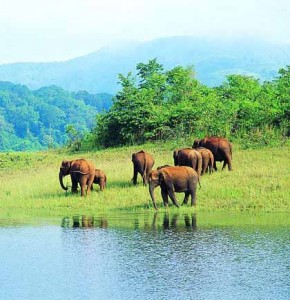 anctuary. Although walking into the sanctuary on one’s own is discouraged by the Forest Department, it is possible to go on treks with tribal guides and there are watchtowers overlooking pools which can be used. It must be remembered, however, that the animals feel most comfortable and allow the closest approach by boat.The only flat areas of Periyar are the marshy grasslands at the ends of the fingers of the lake. The typical habitat is rolling or steep hills. The actual area covered by forest is sometimes surprisingly little, with big areas of grassland between patches of forest. But this is the hallmark of a dynamic ecosystem, that which provides dense forest cover (for shade and browse in the hot months) and, adjacent to it, rich grasslands for the big herbivores.
anctuary. Although walking into the sanctuary on one’s own is discouraged by the Forest Department, it is possible to go on treks with tribal guides and there are watchtowers overlooking pools which can be used. It must be remembered, however, that the animals feel most comfortable and allow the closest approach by boat.The only flat areas of Periyar are the marshy grasslands at the ends of the fingers of the lake. The typical habitat is rolling or steep hills. The actual area covered by forest is sometimes surprisingly little, with big areas of grassland between patches of forest. But this is the hallmark of a dynamic ecosystem, that which provides dense forest cover (for shade and browse in the hot months) and, adjacent to it, rich grasslands for the big herbivores.
The forests of Periyar can be divided into four broad categories. The open grasslands, studded with fire-resistant vegetation, harbor many species of grasses such as elephant grass. These are the common dining hall of all the herbivores, from the gaur and elephant to the small wild boar and barking deer. Then we have the most deciduous forest type dominated by trees like Termamnalama and teak (Teciona grandams) which lose their leaves seasonally.
The semi-evergreen forest occurs along wet stream areas and is often adjacent to the tropical evergreen forests. And lastly, the climax forests: the sholas or tropical evergreen jungle which occurs in the valleys and where one can see trees 100 to 130 feet (30 to 40 meters) high. The dense treecanopy allows only a limited stream of sunlight through and in the moist, dark corridors, ferns, orchids and airplants abound. Also to be found here is the small but efficient parasite, the leech. Leeches live on blood and prey mostly on warm-blooded animals that periodically pass through their territory. But there are obviously not enough game animals to go around, as visitors may find to their dismay, and a juicy human limb is always welcome.
There is probably no sanctuary in the world where elephant behavior can be watched in such absolute comfort and safety. It was here that the writer and her colleagues first appreciated the great repertoire of elephant sounds, some which are startlingly human. The total elephant population is about 800 and one can approach to within 20 yards (20 meters) of placid groups feeding, bathing and swimming. Often, after a swim, elephants indulge in their 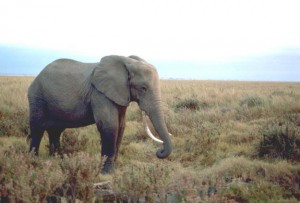 own brand of mudslinging; trunkfuls of dust are sprayed on their backs, an activity which may decrease parasite infestation and protect them from the sun. But whatever the reason, it is a spectacular sight. Unlike their African cousins, female Indian elephants have no tusks. In fact not all bulls have tusks either. Tuskless males are called mak nas. A male tusker is of course a magnificent animal, but it may be that the niaknas are the lucky ones, because sustained poaching for ivory has wiped out most of the big tuskers in South Indian jungles. The high stakes involved make poachers increasingly daring and bold, and forest officials have an almost insurmountable problem on their hands. The ivory criminals have in recent years started hanging live wires to electrocute elephants. Also, tuskers are singled out and crippled by a shot in the knee; the helpless animal is then closely approached and killed. It is equally tragic when a wounded elephant manages to get away from its killers. People report that tuskers with a crippled leg use their tusk as a crutch for support.
own brand of mudslinging; trunkfuls of dust are sprayed on their backs, an activity which may decrease parasite infestation and protect them from the sun. But whatever the reason, it is a spectacular sight. Unlike their African cousins, female Indian elephants have no tusks. In fact not all bulls have tusks either. Tuskless males are called mak nas. A male tusker is of course a magnificent animal, but it may be that the niaknas are the lucky ones, because sustained poaching for ivory has wiped out most of the big tuskers in South Indian jungles. The high stakes involved make poachers increasingly daring and bold, and forest officials have an almost insurmountable problem on their hands. The ivory criminals have in recent years started hanging live wires to electrocute elephants. Also, tuskers are singled out and crippled by a shot in the knee; the helpless animal is then closely approached and killed. It is equally tragic when a wounded elephant manages to get away from its killers. People report that tuskers with a crippled leg use their tusk as a crutch for support.
Poaching and human encroachment are “the biggest problems that the 150-strong Forest Department staff have to contend with. Kerala has the highest human density figures in India and Periyar is an island surrounded by human habitation. Cattle grazing has become a serious problem. Cattle within the park disturb the wildlife, stop effective grass growth and  compete with the herbivores for food. But their presence in the reserve can have much more serious consequences. In 1974-1975, the dreaded rinderpest disease which fatally affects bovines and which is spread by cattle, reached epidemic proportions in South India. A thousand gaur died from it in leriyar. The Forest Department is working out a plan to ensure, through a system of ear tags, that all cattle in adjoining areas are i mmunized against rinderpest.
compete with the herbivores for food. But their presence in the reserve can have much more serious consequences. In 1974-1975, the dreaded rinderpest disease which fatally affects bovines and which is spread by cattle, reached epidemic proportions in South India. A thousand gaur died from it in leriyar. The Forest Department is working out a plan to ensure, through a system of ear tags, that all cattle in adjoining areas are i mmunized against rinderpest.
A typical sight in leriyar are the darters and cormorants which bask on the remnant poles of the submerged forest, and allow tourist boats to approach to within yards of them without fear. The depth of the lake excludes wading birds but offers splendid opport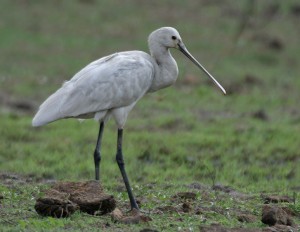 unities for anglers such as ospreys, kingfishers and kites. Otters, also expert fishermen, are a common sight, fishing in the shallows or bounding along the shore with their wet fur gleaming in the sun. Both the great hornbill and the gray hornbill can he easily seen in Periyar. Several fruit trees just around the boat landing area attract these hornbills, hill mynas, orioles and racket-tailed drongos. Very often, the first sign of a great hornbill is the whoosh, whoosh, whoosh of its wings as the heavy bird flies overhead. Both hornbills have a somewhat hysterical laughing call, one of the loudest sounds of the forest. Above the forest office at the boat landing, a family of storks have nested for decades in a very tall tree.
unities for anglers such as ospreys, kingfishers and kites. Otters, also expert fishermen, are a common sight, fishing in the shallows or bounding along the shore with their wet fur gleaming in the sun. Both the great hornbill and the gray hornbill can he easily seen in Periyar. Several fruit trees just around the boat landing area attract these hornbills, hill mynas, orioles and racket-tailed drongos. Very often, the first sign of a great hornbill is the whoosh, whoosh, whoosh of its wings as the heavy bird flies overhead. Both hornbills have a somewhat hysterical laughing call, one of the loudest sounds of the forest. Above the forest office at the boat landing, a family of storks have nested for decades in a very tall tree.
Apart from elephants, another herbivore commonly seen is the wild pig. Sounders of 30 or 40 animals are common in Periyar. With its stiff upright mane and disgruntled expression, the pig lends a comic touch to the Periyar scene. The wild pig is an opportunistic feeder and not wholly vegetarian; at Point Calimere on the Tamil Nadu coast, they even dig up and eat the eggs of sea turtles. Sambar, barking deer and mouse deer are the representatives of the deer family in Periyar; interestingly, the spotted  deer or chital is absent. An experiment was tried several years ago and a group of chital released on an island in the sanctuary, but they apparently didn’t survive. Some of the high hill crests within Periyar are inhabited by the last Nilgin tahr in the area but they are generally too shy and elusive to be seen.
deer or chital is absent. An experiment was tried several years ago and a group of chital released on an island in the sanctuary, but they apparently didn’t survive. Some of the high hill crests within Periyar are inhabited by the last Nilgin tahr in the area but they are generally too shy and elusive to be seen.
On rocky shelves called paarai along the lakeshore one may see a large dark monitor lizard basking in the midday sun especially in the cooler months. Pythons are fairly regularly seen by the trekking guides and in the evergreen areas an occasional king cobra is sighted. Among the smaller reptiles, two spectacular species are the flying lizard and the fl ying snake. The flying lizard is hard to see because of its cryptic lichen-like coloration but gliding from one tree to another, its wings are brilliant yellow or orange. An observant naturalist can spot them on a sunny tree trunk by patiently looking for the male, who flaps a tell-tale yellow dewlap or throat flap. The flying snake on the other hand is one of the most colorful snakes in the country with a brilliant pattern of yellow and black, with reddish rosettes. Flying snakes don’t really fly, of course, but can launch themselves and flatten their bodies to make an extended “flight” to a lower branch or tree. Yet another flying creature is the incredible flying frog, not uncommon in parts of the sanctuary especially during the rains. It “flies,” or glides, by extending its toes which are all connected by extra-wide webbing.
ying snake. The flying lizard is hard to see because of its cryptic lichen-like coloration but gliding from one tree to another, its wings are brilliant yellow or orange. An observant naturalist can spot them on a sunny tree trunk by patiently looking for the male, who flaps a tell-tale yellow dewlap or throat flap. The flying snake on the other hand is one of the most colorful snakes in the country with a brilliant pattern of yellow and black, with reddish rosettes. Flying snakes don’t really fly, of course, but can launch themselves and flatten their bodies to make an extended “flight” to a lower branch or tree. Yet another flying creature is the incredible flying frog, not uncommon in parts of the sanctuary especially during the rains. It “flies,” or glides, by extending its toes which are all connected by extra-wide webbing.
Among the predators of Periyar is the wild dog or dole , which is fairly commonly seen along the lakeshores and adjoining forests. There are about 50 packs of these carnivores here and they hunt deer, wild pig and other game collectively and alone. Sometimes you may hear the high-pitched, eerie whistle of a wild dog on the hunt. Prey animals typically run to the lake to escape. Wild dogs are much maligned for their socalled “cruelty” and in the past were shot even within sanctuaries, as vermin. In fact, wild dogs are important predators in the food chain of the jungle. As for their cruelty: every carnivore from tigers to spiders must kill for food.
There are several animals which can be seen around the rest houses and other habitations within the sanctuary. After dark, porcupines and wild pig scuffle around garbage dumps and vegetable patches. There are four species of monkeys here: the rare and endangered lion-tailed macaque, the Nilgiri langur, the common langur along the eastern boundaries, and the bonnet macaque around peripheral areas of the sanctuary. The beautiful Malabar squirrel allows fairly close approach at times and one can often hear its loud, excited chatter in the trees. Another large squirrel which lives here is the flying squirrel hut, being nocturnal, watch and listen for it on bright moonlit nights. It makes spectacular glides between trees which may extend to two to three hundred yards (180 280 meters).
Flying squirrels make a fairly loud, plaintive cooing sound which is distinctive if you know what to listen for.The lucky tourist may even see a tiger, which is at the apex  of the food chain and which was not long ago in danger of becoming extinct. At the turn of the century there were over 40,000 tigers in India. But sport hunters and commercial interests persecuted the animal so relentlessly that by 1962 less than 200 animals survived. Together with the World Wildlife Fund, the Government of India launched Project Tiger, with a million dollars raised by the WWF to save the animal and its habitat. Project Tiger has been acclaimed one of the most successful conservation campaigns ever undertaken. There are now an esti mated 40 tigers in Periyar which seem to be holding their own with little or no increase in numbers.
of the food chain and which was not long ago in danger of becoming extinct. At the turn of the century there were over 40,000 tigers in India. But sport hunters and commercial interests persecuted the animal so relentlessly that by 1962 less than 200 animals survived. Together with the World Wildlife Fund, the Government of India launched Project Tiger, with a million dollars raised by the WWF to save the animal and its habitat. Project Tiger has been acclaimed one of the most successful conservation campaigns ever undertaken. There are now an esti mated 40 tigers in Periyar which seem to be holding their own with little or no increase in numbers.
If you express a particular interest, for example birds, primates etc., the Forest Department is most helpful and the guide provided for trekking, usually a Marian tribal with a vast knowledge of the natural history of the area, will be able to point out things of particular interest. Daytime as well as nighttime periods can be spent on watchtowers, away from the main tourist activity.Shy, timid animals like the gaur, India’s largest bovine, prefer the seclusion of the swampy grasslands near Eddapaliyam and other areas associated with watchtowers.
With permission and an accompanying guide, one can trek or boat to the source of the Periyar Lake, the Periyar river. This is in the core area of the park, normally not open to visits, and the rest house situated there is known as Thannikudi. From here, armed guards patrol a huge 85-sq-mile (220-sq-km) beat to guard against animal and wood poachers. The Periyar is a beautiful, clear river and it is not uncommon to see the dark shapes of yard-long 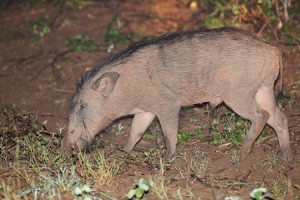 mahseer, a game fish made famous by shikar writers such as Jim Corbett, gliding just beneath the surface. Here in Thannikudi the sloth bear is common; its signs are everywhere. This is also where tigers can live in peace, away from the main forest activities which are still permitted within the sanctuary. For those who are anthropologically inclined, there are a few interesting tribal villages near the sanctuary. Among the tribals in this area are the Manans and the Ooralis; the latter still build tree dwellings, these days not so much as residences but as watchtowers to keep animals like wild pig, sambar and elephants from their crops. The Manans are expert fishermen and fish the lake and the clear streams that run into it for mahseer. A few Manans traditionally practice the dangerous exercise of collecting honey of the hill bees. These are large and potentially dangerous bees which build massive hives high in the branches of rain forest trees such as the silk cotton, Bombay. For climbing to these often 100-foot (30- meter) high honeycombs, they carve bamboo spikes which they hammer into the tree with a wooden mallet. They only do this at night to avoid being stung, and sometimes collect 55 lb (25 kg) of honey at a time from one tree.
mahseer, a game fish made famous by shikar writers such as Jim Corbett, gliding just beneath the surface. Here in Thannikudi the sloth bear is common; its signs are everywhere. This is also where tigers can live in peace, away from the main forest activities which are still permitted within the sanctuary. For those who are anthropologically inclined, there are a few interesting tribal villages near the sanctuary. Among the tribals in this area are the Manans and the Ooralis; the latter still build tree dwellings, these days not so much as residences but as watchtowers to keep animals like wild pig, sambar and elephants from their crops. The Manans are expert fishermen and fish the lake and the clear streams that run into it for mahseer. A few Manans traditionally practice the dangerous exercise of collecting honey of the hill bees. These are large and potentially dangerous bees which build massive hives high in the branches of rain forest trees such as the silk cotton, Bombay. For climbing to these often 100-foot (30- meter) high honeycombs, they carve bamboo spikes which they hammer into the tree with a wooden mallet. They only do this at night to avoid being stung, and sometimes collect 55 lb (25 kg) of honey at a time from one tree.
Spending a few days in Periyar is a unique and unforgettable experience. Here is one sanctuary where you never travel by road; no traffic noise, no dust, no bumps. Most important, one is not trespassing on the animals’ territory.
These are among the many advantages of a sanctuary that is only traversed by boat, and where the thousands of tourists leave no footprints.



